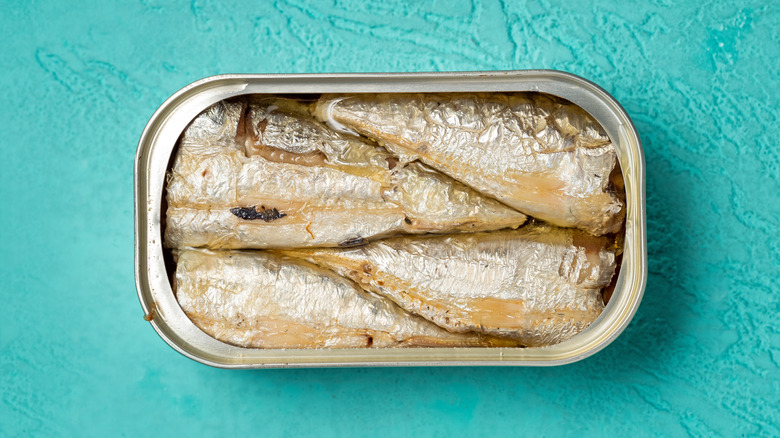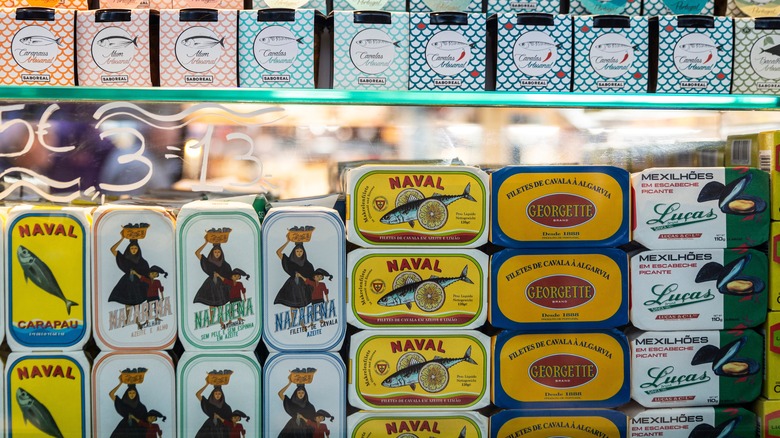Should You Look For Bones In Canned Sardines?
There's nothing worse than painstakingly picking all the bones out of a whole fish, only to feel a sharp prick in your throat mid-meal. If this task sounds even more nerve-wracking with tiny fish, don't worry when it comes to sardines. Typically canned with both the skin and bones still intact, sardines can be eaten whole with no problem. This even includes the sardine head, though most canned varieties have already removed it.
The heat treatment during the packaging process causes sardine bones to soften inside their tiny can homes. After that, their texture becomes so easy to eat that most consumers don't even notice the bones when serving them. There are health benefits to eating these tasty little fish whole, too. Sardines are packed with omega-3 fatty acids and other nutrients such as iron, potassium, and various vitamins. In fact, whole sardines canned in oil contain five times the calcium, four times the vitamin D, and 1½ times the iron of the skinless and boneless variety canned in oil.
How to choose canned sardines
Don't get overwhelmed by the canned fish section of the grocery store. Simply start by reading the label, and keep an eye out for a few important distinctions. First, decide if you prefer sardines with or without skin and bones — both varieties are often available for purchase. It all depends on what type of dish you're preparing. Whole sardines can make for an impressive presentation, like when laid atop a rice dish or lightly chopped and sprinkled over a dip. Skinless and boneless sardines have a less firm texture and more subtle taste, making them ideal for mashing into sauce or shredding for a salad.
Secondly, check what the sardines are packed in. Most times it will be water, oil, or a sauce. To allow the fish's natural flavor to stand out, you should follow Alton Brown's rule of always buying sardines canned in olive oil. Not only does the taste of the oil complement the fish, but it also can be drizzled on other dishes, like pasta or salad, to add some seafood notes to any meal.
Other important label information to watch for is how the sardines are sourced. Lots of canned fish fans prefer sourcing from Mediterranean cultures where seafood is prevalent, like Portugal or Spain. Or, if sustainability is important to you, keep an eye out for the Marine Stewardship Council's blue logo that adorns some cans. This shows the sardines were caught following sustainable methods.
Ways to cook with canned sardines
While some fish fans end up eating a tin of sardines over the sink as a midnight snack, there are more ways to enjoy this seafood beyond simply opening the lid. To get the most upfront flavor, try a few sardines on a piece of toast or a cracker with your favorite spread, like cream cheese or mustard. Dress up these bites with some freshly chopped herbs, a little lemon zest, and a drizzle of olive oil to make an impressive appetizer option.
For actually cooking with canned sardines, you can't go wrong with pasta. Mashing a few sardines (and a drizzle of the can's oil) into the recipe, as seen in Zakary Pelaccio's pasta con sarde — which pairs sardines with fennel and tomatoes — can give it that Mediterranean flair and an extra depth of flavor. Remember to set aside a few whole sardines for laying atop the final dish to create a beautiful presentation.
Another popular way of enjoying sardines is giving them a quick hit of heat: whether that's a brief trip to the frying pan, a few minutes over the grill (using a grill basket for easiest cooking), or even baking in the air fryer. No matter what method you use, don't forget to boil some cinnamon water to help your kitchen get rid of the fishy smell afterward.



